

Fabolous "I'm Raw": A Close Reading. By Diplopotamus Originally published in The Believer Central Question: Is impeccable but empty rhetoric dangerous?

Close Reading Assignments. Paper Genre A Close Reading (or Explication de texte) operates on the premise that any artistic creation will be more fully understood and appreciated to the extent that the nature and interrelations of its parts are perceived, and that that understanding will take the form of insight into the theme of the work in question.
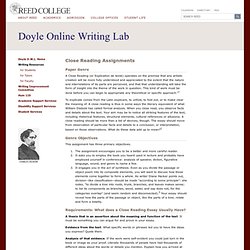
This kind of work must be done before you can begin to appropriate any theoretical or specific approach. "1 To explicate comes from the Latin explicare, to unfold, to fold out, or to make clear the meaning of. A close reading is thus in some ways the literary equivalent of what William Diebold has called formal analysis. When you close read, you observe facts and details about the text.
How to do a Close Reading. Close Reading Example. Savage and Superb: The Native Woman at Kurtz's Station by Shasta Turner A close reading is a paper (usually 4 to 5 pages long, but sometimes longer) on a short poem or an excerpt from a longer poem or prose work.
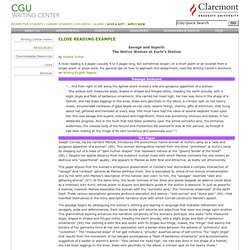
For general tips on how to approach this assignment, read the Writing Center's brochure on Writing English Papers. "... And from right to left along the lighted shore moved a wild and gorgeous apparition of a woman. Joseph Conrad, via his narrator Marlow, introduces the anonymous native woman at Kurtz's camp as a "wild and gorgeous apparition of a woman" (99). This paper argues that the woman's ambiguous presentation in Conrad's text illuminates a complex intersection of "savage" and "civilized" spheres as Marlow portrays them. The passage begins by cataloguing the woman's clothing and bearing in language that indicates refinement and savagery, pride and defensiveness. The woman's position is thus powerful in one sense and subordinate in another. Writing About Fiction. Summary: This handout covers major topics relating to writing about fiction.
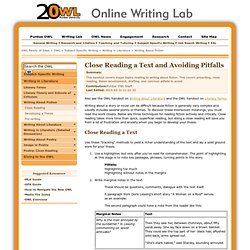
This covers prewriting, close reading, thesis development, drafting, and common pitfalls to avoid. Contributors:Purdue OWL StaffLast Edited: 2014-03-31 11:22:32 Also see the OWL handout on Writing about Literature and the OWL handout on Literary Terms. Poetry: Close Reading. Introduction Once somewhat ignored in scholarly circles, close reading of poetry is making something of a comeback.
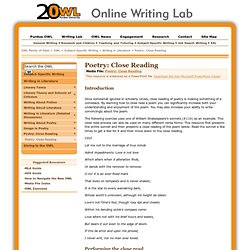
By learning how to close read a poem you can significantly increase both your understanding and enjoyment of the poem. You may also increase your ability to write convincingly about the poem. The following exercise uses one of William Shakespeare’s sonnets (#116) as an example. This close read process can also be used on many different verse forms. Let me not to the marriage of true minds Admit impediments. Which alters when it alteration finds, Or bends with the remover to remove: O no! That looks on tempests and is never shaken; It is the star to every wandering bark, Whose worth's unknown, although his height be taken. What is close reading? - a tutorial and guidance notes « Mantex.
McClennen's Close Reading Guide. Dr.
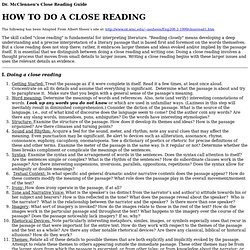
McClennen's Close Reading Guide The following has been Adapted From Albert Sheen's site at: The skill called "close reading" is fundamental for interpreting literature. "Reading closely" means developing a deep understanding and a precise interpretation of a literary passage that is based first and foremost on the words themselves. But a close reading does not stop there; rather, it embraces larger themes and ideas evoked and/or implied by the passage itself. I. Getting Started: Treat the passage as if it were complete in itself.
Note that this process moves from the smallest bits of information (words, sound, punctuation) to larger groupings (images, metaphors) to larger concepts (themes). II. The paper should begin with a closely argued thesis, which is the result of the last step above. Lynch, Getting an A on an English Paper. John Lye's Courses and Sources Pages. A Guide Designed for His Year 1 Students by Professor John Lye Copyright John Lye 1996, 1997 This is a guide to what you might look for in analyzing literature, particularly poetry and fiction.

An analysis explains what a work of literature means, and how it means it; it is essentially an articulation of and a defense of an interpretation which shows how the resources of literature are used to create the meaningfulness of the text. There are people who resist analysis, believing that it 'tears apart' a work of art; however a work of art is an artifice, that is, it is made by someone with an end in view: as a made thing, it can be and should be analyzed as well as appreciated. There are several main reasons for analyzing literature: The ultimate end of analysis is, first and foremost, a deeper understanding and a fuller appreciation of the literature -- you learn to see more, to uncover or create richer, denser, more interesting meanings. I: Critical Analysis of Poetry 1. 2. 3. 4. 5. 6. Become a Better Reader and Improve Your Writing Skills.